44 Key Digital Marketing Statistics for Strategic Growth in 2024

We all see that digital marketing is slowly but steadily overtaking traditional marketing channels as companies’ favorite marketing method.
Platforms like Google or Facebook ads offer a more cost-effective solution, better audience targeting, and measurable metrics when compared to television commercials, for example.
That said, you have to look at the numbers to truly understand the power of digital marketing. In this article, we’ve curated facts and statistics about digital marketing that will benefit your brand’s growth in 2024 and beyond.
Download Checklist: How to Start an Online Business
Top 10 Digital Marketing Stats You Should Know
- The global market value of digital marketing will reach around $1.3 trillion by 2033.
- More than 50% of company marketing budgets go to paid media and new technologies.
- Mobile advertising will account for 70% of the total ad spending by 2028.
- Companies allocate the majority of their ad budget to social display and search advertising.
- Around 84% of B2B marketers managed to create brand awareness through content marketing.
- Blogs are used by 76% of marketers to distribute content, making them the most popular form of content marketing.
- Short-form videos bring higher engagement and ROI than longer ones.
- On average, the first result on Google generates 39.8% of all clicks. If it’s a featured snippet, the click-through rate increases to 42.9%.
- Nearly half of millennials believe influencer recommendations more than regular ads when buying a product.
- Generative AI is the driving force behind marketing technology’s continuous growth in recent times.
Marketing and Digital Marketing Trends
In this section, you will learn the sheer size and potential of the online marketing industry, and why you should start investing in digital platforms.
1. Global Digital Marketing Market Size Is Expected to be Worth Around $1.3 Trillion by 2033
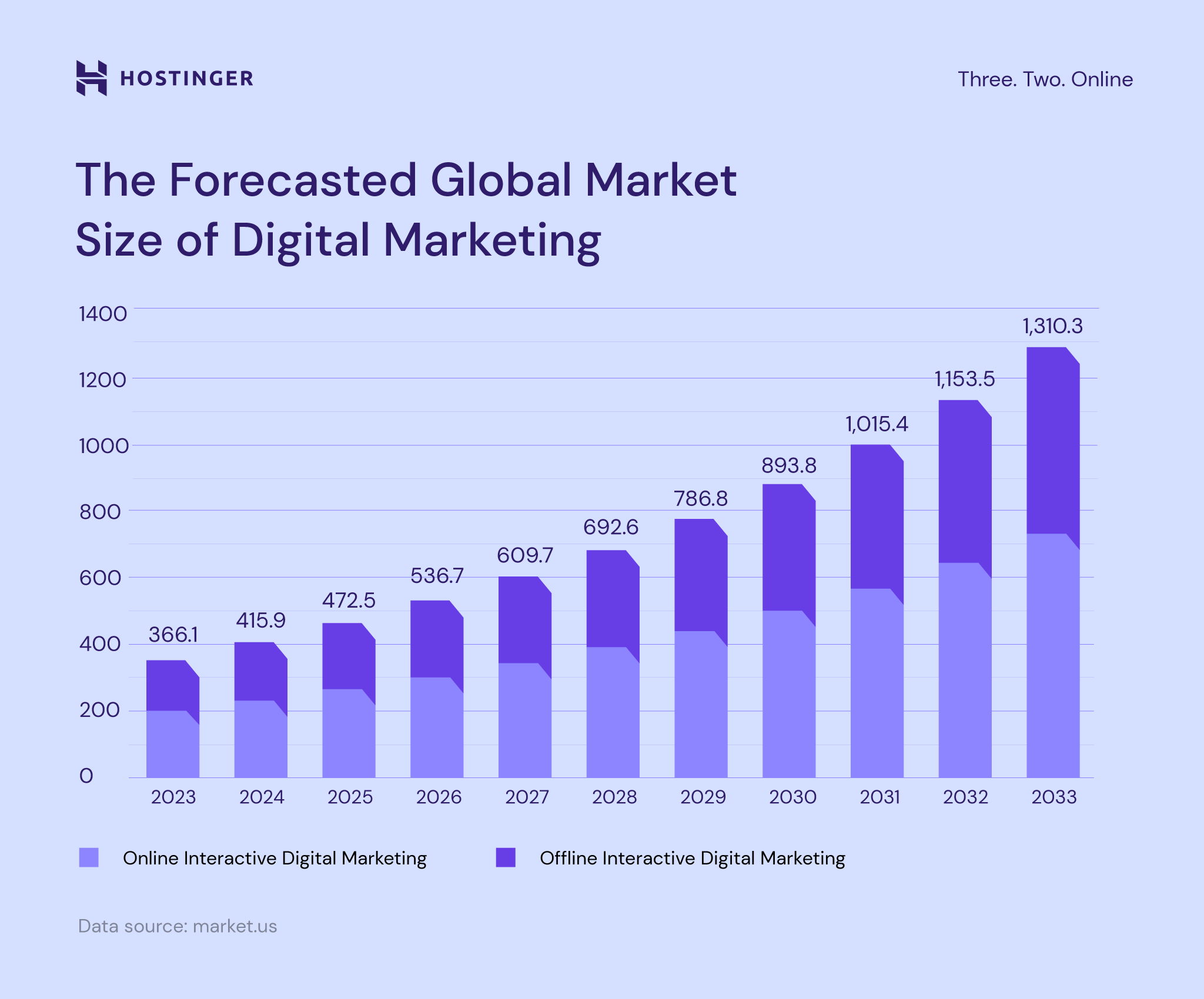
In 2023, the market value of digital marketing reached $366 billion, and it will continue to grow at a compound annual growth rate of 13.6% for the next decade.
Convenience is one of the key factors that contribute to the popularity of digital platforms, as consumers can easily find entertainment and shop online from the comfort of their home.
2. North American and European Companies Allocated 9.1% of Their Total Revenue to Marketing in 2023
Seeing that digital marketing actually works, most chief marketing officers (CMOs) in North America and Europe are planning to increase their budgets for social media advertising, online videos, and influencer marketing.
3. Paid Media and Marketing Technology Make up 51% of Marketing Budgets
Companies in North America and Europe allocate 25.6% of their financial plans to paid media, including pay-per-click (PPC) campaigns, video ads, and sponsored social media posts.
Marketing technology, which refers to software or systems marketers use to achieve their goals, takes second place with a 25.4% share. The remaining portions of the budget go to labor (24.6%) and agencies (23.3%).
4. About 82% of Marketing Leaders Reprioritize Investments in Digital Channels
Amidst the market volatility in recent times, marketing leaders are forced to adjust their strategy to optimize growth and return on investment (ROI). 82% of CMOs chose to reprioritize investments in digital channels, while only 59% adjusted offline channels.
5. Improved Marketing Data Leads to a Better Customer Experience
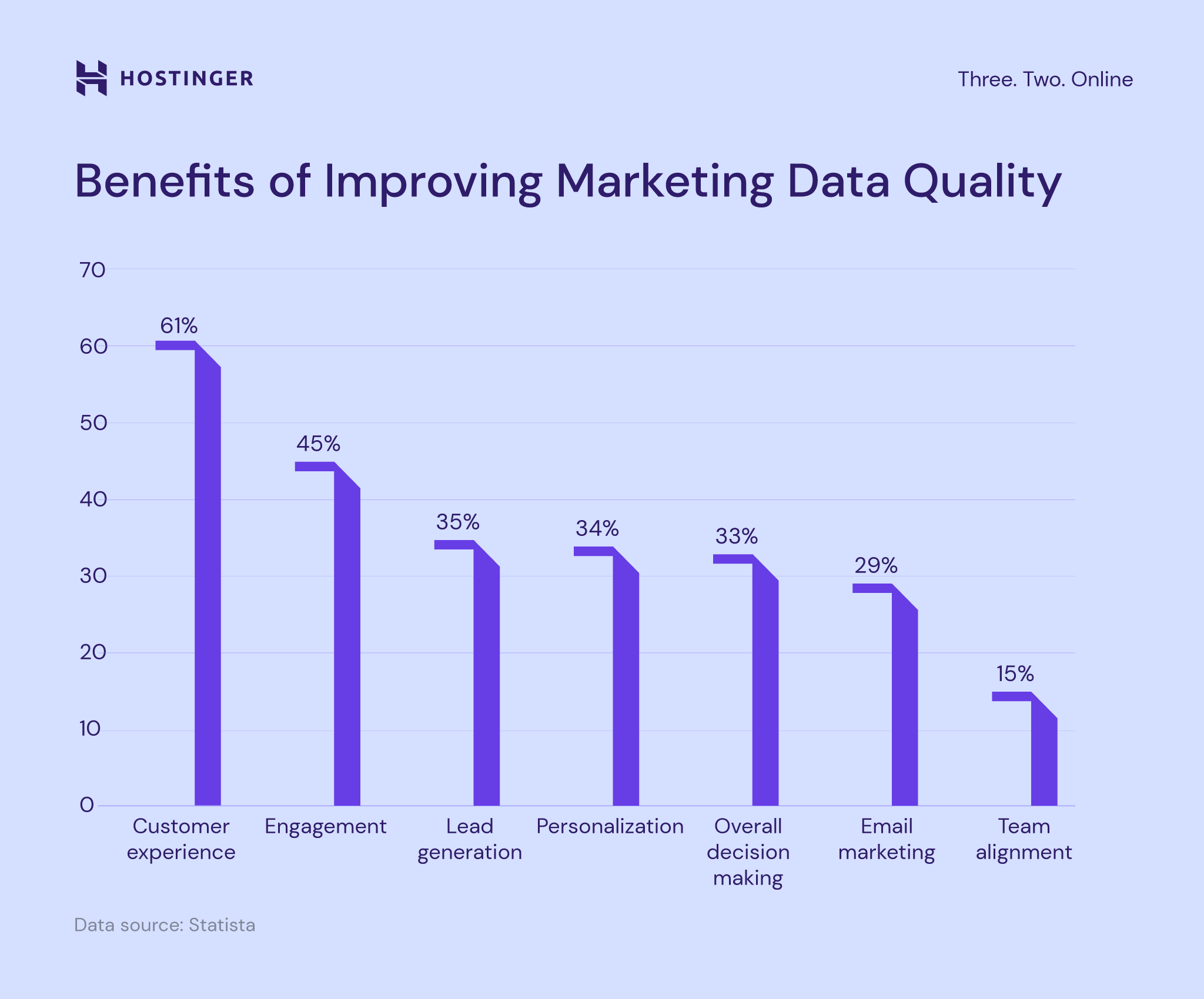
Analytics and market research tools help marketers gather customer data more accurately.
As the quality of data improves, which areas benefit from it most? 61% of marketing leaders said customer experience, 45% cited engagement, while the rest mentioned lead generation (35%), personalization (34%), and the overall decision-making process (33%).
Digital Advertising Statistics
Over the past decade, the number of internet users has grown significantly, contributing to the rapid increase in social media consumption and online shopping.
With this shift in consumer behavior, companies are willing to spend more on digital advertising, slowly leaving behind traditional marketing channels.
Read on to learn more about the current state and upcoming trends of digital advertising.
6. Global Digital Advertising Market Is Expected to Reach $740 Billion in 2024
In comparison, the global market size of television advertising was worth around $235 billion in 2023. This substantial gap shows that businesses have become more reliant on digital platforms to reach their target audiences.
Wider reach, lower costs, better targeting capabilities, and measurable results are several advantages that digital advertising has over its traditional counterpart.
7. Mobile Advertising Will Comprise 70% of the Total Ad Spending by 2028
These days, consumers mostly use their phone to browse the internet, and mobile usage will grow even more in the years to come. If you want to stay competitive, engaging in mobile marketing has become a must rather than an option.
8. Display Advertising Has the Largest Ad Spend Share
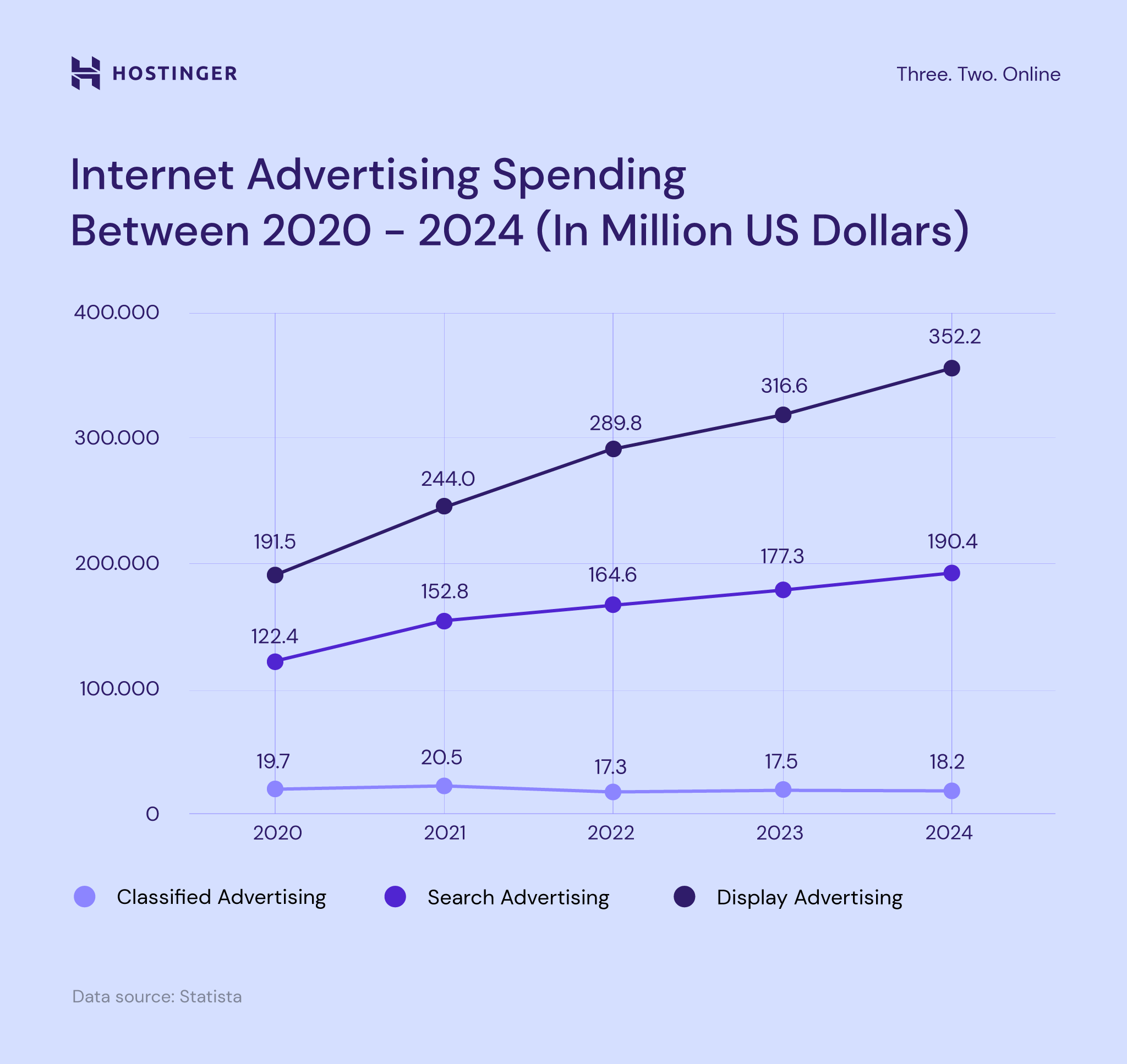
By the end of 2024, display advertising spending is projected to reach $352.3 billion, while search advertising will amount to $190.5 billion. Classified advertising would have the least amount of spending with roughly $18 million.
9. Video Advertising Market Will be Worth Around $191 Billion in 2024
Users spend 6 hours and 48 minutes on average watching online videos each week. So, it comes as no surprise that companies are willing to invest $34.5 per internet user to create and promote video ads.
10. Google and Facebook Continue to Dominate the Advertising Space
Google has the largest digital advertising revenue among other tech companies. By 2026, the search engine platform is projected to generate around $357 billion, comprising roughly 44% of the global ad earnings.
The second major player in the digital advertising world is Facebook, which is expected to earn $203 billion from ads in the same period.
Content Marketing Statistics
For small business owners with a limited budget, content marketing serves as the more affordable strategy to drive website traffic. Although the results won’t come as easy and fast as search advertising, your effort will pay dividends in the long run.
Let’s take a closer look at the six most important content marketing statistics you should know.
11. Content Marketing Revenue Will Increase by Almost 50% Between 2022 and 2026
In 2022, the global revenue of the content marketing industry was estimated at $63 billion, and it’s expected to grow almost double to $107.5 billion by 2026.
12. Around 84% of B2B Marketers Successfully Created Brand Awareness Through Content Marketing
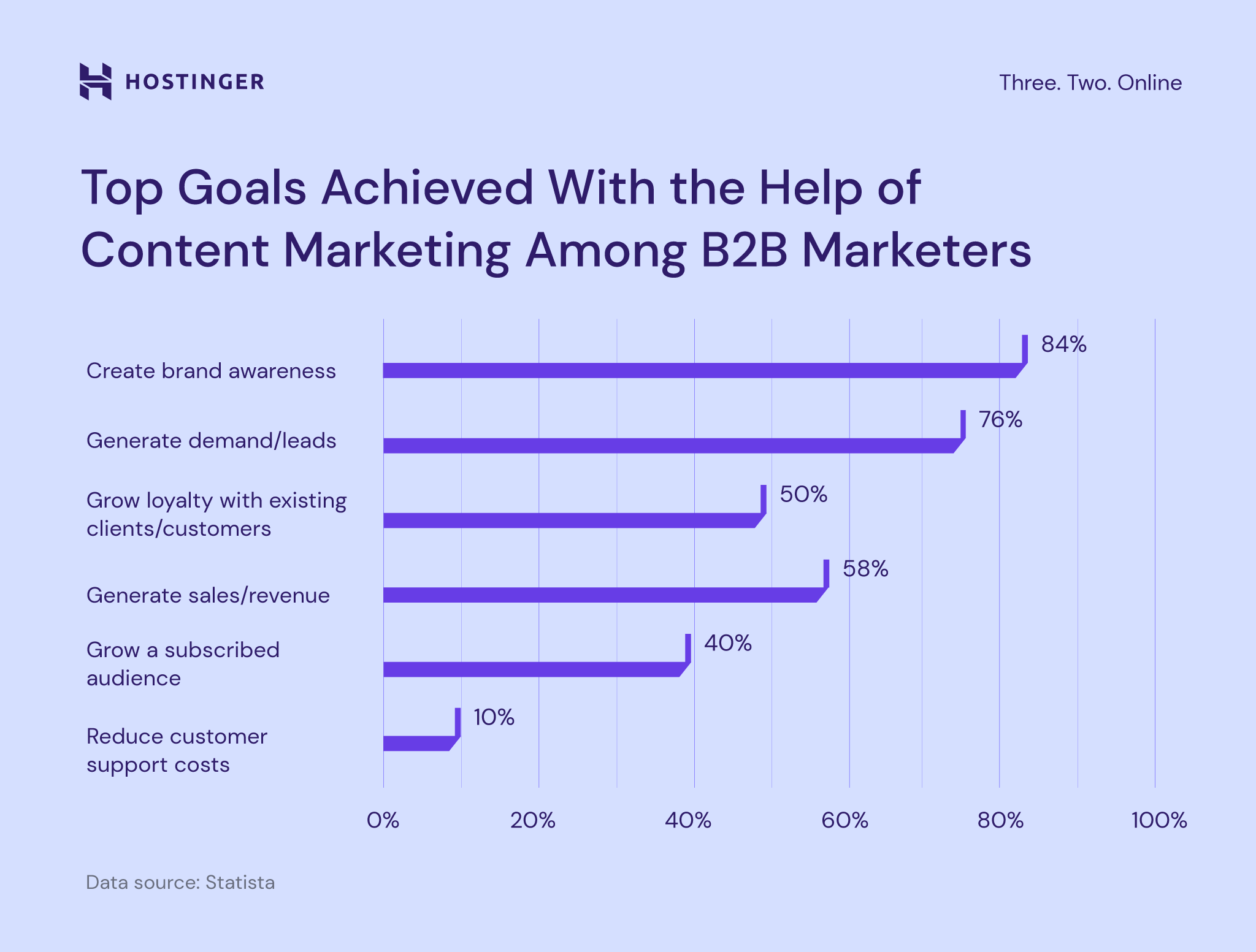
When asked about which marketing goals they managed to achieve with the help of content marketing, 84% of respondents said brand awareness, 76% cited demand generation, and 58% mentioned sales boost.
With the right content marketing strategy, B2B marketers were also able to increase customer loyalty (50%), grow a subscriber list (40%), and reduce customer support costs (10%).
13. Blog Is the Most Popular Content Format
A whopping 76% of marketers use blog posts to distribute content. In terms of results, 10% said that blog content brings the best ROI, with 36% agreeing that it performs better than case studies, webinars, infographics, eBooks, and podcasts.
Interestingly, more than half (55%) of bloggers believed that producing high-quality content is more important than making it SEO-friendly and partnering with influencers.
14. The Majority (66%) of Brands Have a Well-Defined Content Strategy
Customer research, community building, and content quality improvement were the most heavily funded areas of content marketing.
As for the winning tactics, most experts highlighted the importance of publishing more often and combining SEO with creative storytelling.
15. Marketers Measure Content’s Impact by Organic Traffic and Social Media Engagement
Surprisingly, ranking high on the search engine results page (SERP) is no longer the top priority for most brands and marketers.
Instead, they want to focus more on generating high-converting traffic through guest blogging on authoritative sites, building an email list, and engaging with the target audience on social media platforms like LinkedIn, Reddit, and Quora.
16. Thanks to AI, 68% of Companies Managed to Increase Content Marketing ROI
Among those brands, 39% felt a moderate ROI increase, and 29% saw a significant rise compared to when AI tools weren’t involved.
However, 21% of the respondents thought that their ROI stayed more or less the same, 10% weren’t sure, and 1% experienced an ROI decrease.
Video Marketing Statistics
The human brain is designed to process visual information faster than text, which is why videos are so effective in capturing the audience’s attention.
In this section, we will present facts about video marketing, so you can exploit its full potential to boost user engagement.
17. Roughly 69% of B2B Marketers Invest in Video Marketing in 2024
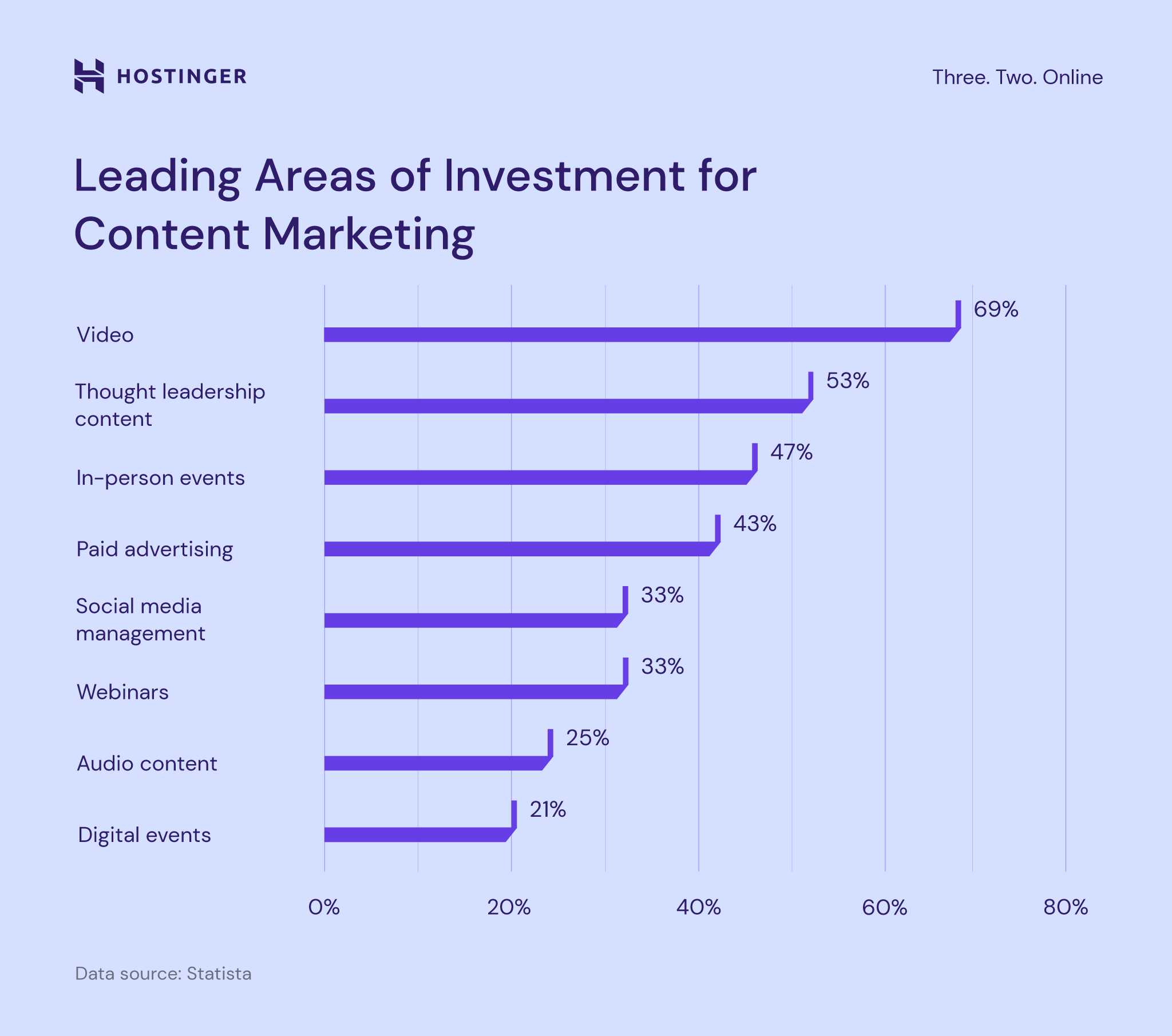
53% said that investing in thought-leadership content is their top priority, while in-person events and paid advertising are the preferred areas of investment for 47% and 43% of B2B marketers, respectively.
Furthermore, 33% choose to focus on social media community building and webinars, and 25% want to create audio content.
18. Over 3 Billion People Watch Online Videos at Least Once a Month
Digital video viewership reached 2.78 billion users worldwide in 2019, and the number will grow to 3.78 billion by the end of 2024. In the US, most people use smartphones to watch video content.
19. Short-Form Videos Bring the Highest Engagement and Return on Investment
With the ever-growing popularity of YouTube Shorts, Instagram Reels, and TikTok, consumers are constantly exposed to short-form video content. If you’re looking to boost engagement, short videos are the best video format to tap into.
39% of marketers agreed that one-minute videos bring the highest engagement and ROI. In contrast, only 16% believed that videos with a duration of three minutes or longer would perform better.
20. YouTube Is the Most Popular Video Marketing Channel
As expected, around 90% of companies use YouTube to promote their video content. Facebook comes second with 86% of brands utilizing it, followed by Instagram (79%) and LinkedIn (79%).
Surprisingly, major video platforms like TikTok and Snapchat have a lower percentage than one might expect, used by only 35% and 13% of brands.
21. Most Businesses Include Videos in Their Marketing Strategy
91% of businesses create videos as a promotion tool, and 96% continue to value videos as an integral part of their marketing strategy. Among those who have yet to use video marketing, 70% plan to follow suit.
22. Nearly Half (47%) of Companies Invest in Product Demo Videos
The top three most invested types of videos are product demos, explainers, and recorded webinars. Meanwhile, brands spent the least amount of money on promos, thought-leadership content, and FAQ videos.
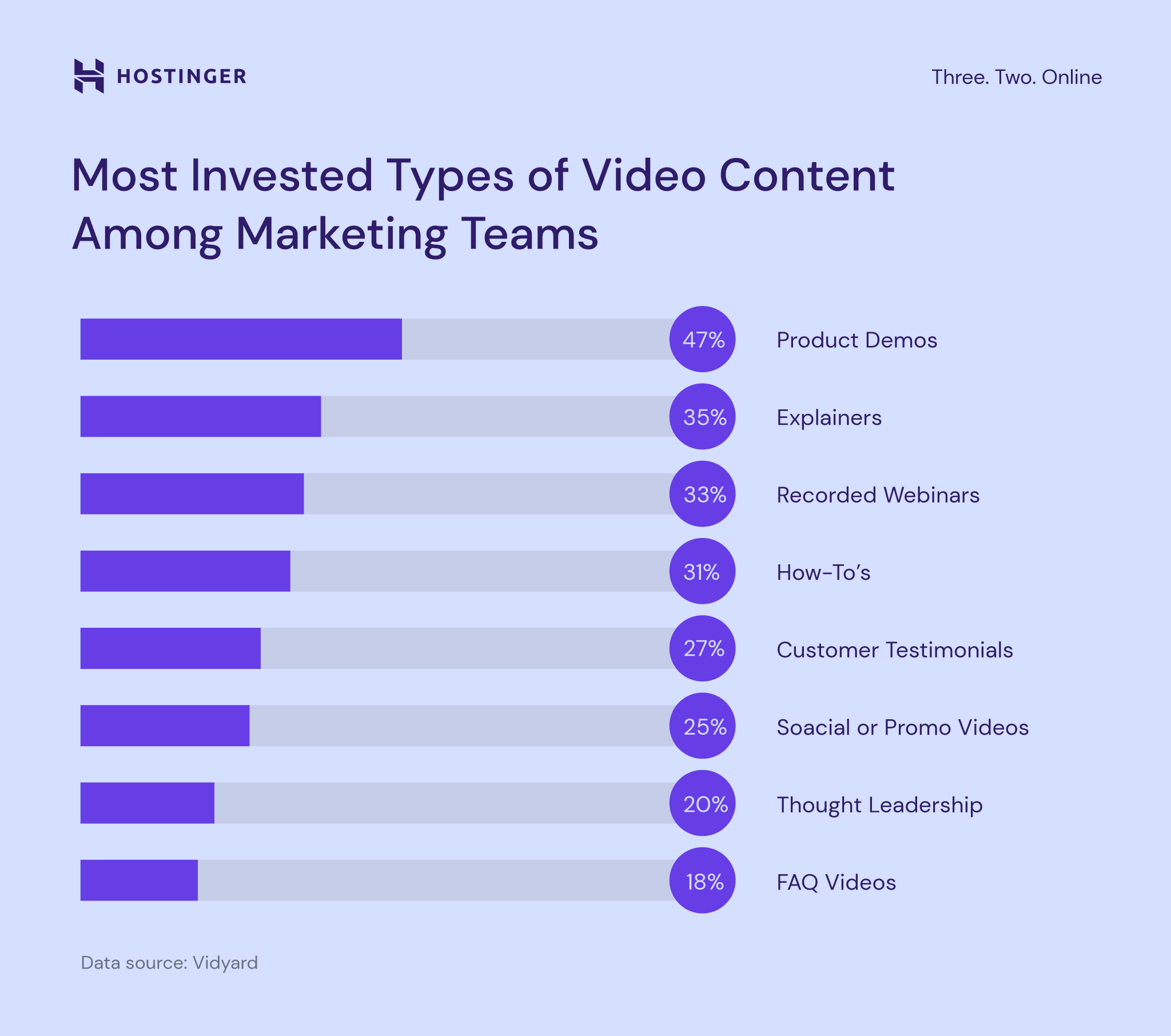
Search Engine Optimization Statistics
Marketers use a search engine optimization (SEO) strategy to make their content stand out on the search engine results page (SERP). When done properly, SEO helps your business site rank higher on Google, which in turn will bring more organic traffic and, ultimately, sales.
Here are some statistics that highlight the importance of SEO in your marketing strategy.
23. Ranking First on Google Means Generating 39.8% of All Organic Clicks
Featured snippets get an even higher share of the traffic, with an average click-through rate (CTR) of 42.9%. For the second and third positions, the number drops significantly to 18.7% and 10.2%, respectively.
24. Google Dominates the Search Engine Market With a 91.37% Share
Bing, as Google’s closest competitor, only gets 3.37% of the global market share. Other popular search engine platforms include Yandex (1.64%), Yahoo (1.1%), Baidu (0.99%), and DuckDuckGo (0.53%).
25. Before Buying, 59% of Online Shoppers Use Google to Find Reviews
According to the latest eCommerce statistics, Google is the go-to platform for most online shoppers when it comes to finding authentic reviews of a product or service.
That’s why, now is the perfect time to set up a Google My Business account, if you haven’t already. Encourage existing customers to leave a positive and honest review on your Google My Business page to improve your online reputation.
26. Mobile Traffic Makes up 84% of All Google Visitors
87% of smartphone owners use a search engine every day, and 60% of consumers discover a new brand or product while browsing on their mobile devices.
Interestingly, 30% of all mobile searches are related to local stores. Among those who search for a nearby business, 76% visit it the very next day.
27. Long-Tail Keywords Tend to Perform Better Than Broad Terms
As a matter of fact, pages targeting key phrases with five to nine words have a 31% CTR, almost twice as many clicks as single-word terms (16.5%).
Although there is no exact answer to this behavior, experts suggest that longer keywords answer user intent better. Visitors know exactly what they’re looking for, and thus are more inclined to click.
28. Organic Search Brings the Highest ROI for Websites Among Other Digital Marketing Channels
When it comes to acquiring website traffic, 49% of marketers found success in organic search, while 19% suggested that paid search yields the highest return on investment.
Furthermore, 18% of the respondents said that investing in social media is the better option, and 14% believed in the power of email marketing in driving a higher ROI.
Email Marketing Statistics
Email marketing is not dead. In fact, it is still one of the most effective strategies to build long-term relationships with your existing audience. Having a business email account will also make your brand look more professional.
The following facts will reveal why you should invest in email marketing despite the popularity of messaging apps and social media platforms.
29. There Will Be 4.73 Billion Email Users in 2026
The current trend doesn’t suggest a dying industry in the slightest. Quite the contrary, the number of email users consistently increased each year from 2017 to 2022, and it’s set to grow to 4.73 billion users by 2026.
30. Global Email Marketing Revenue Is Expected to Reach $17.9 Billion by 2027
Even though the market cap is not as big as content marketing and advertising, the steady growth of email marketing means that it’s still highly effective in driving conversions and nurturing customer relationships.
Email marketing offers direct access to consumers, allowing for personalized communication and targeted messaging. This often results in higher engagement and ROI for your campaigns.
31. Newsletters Are the Most Popular Form of Email Campaigns
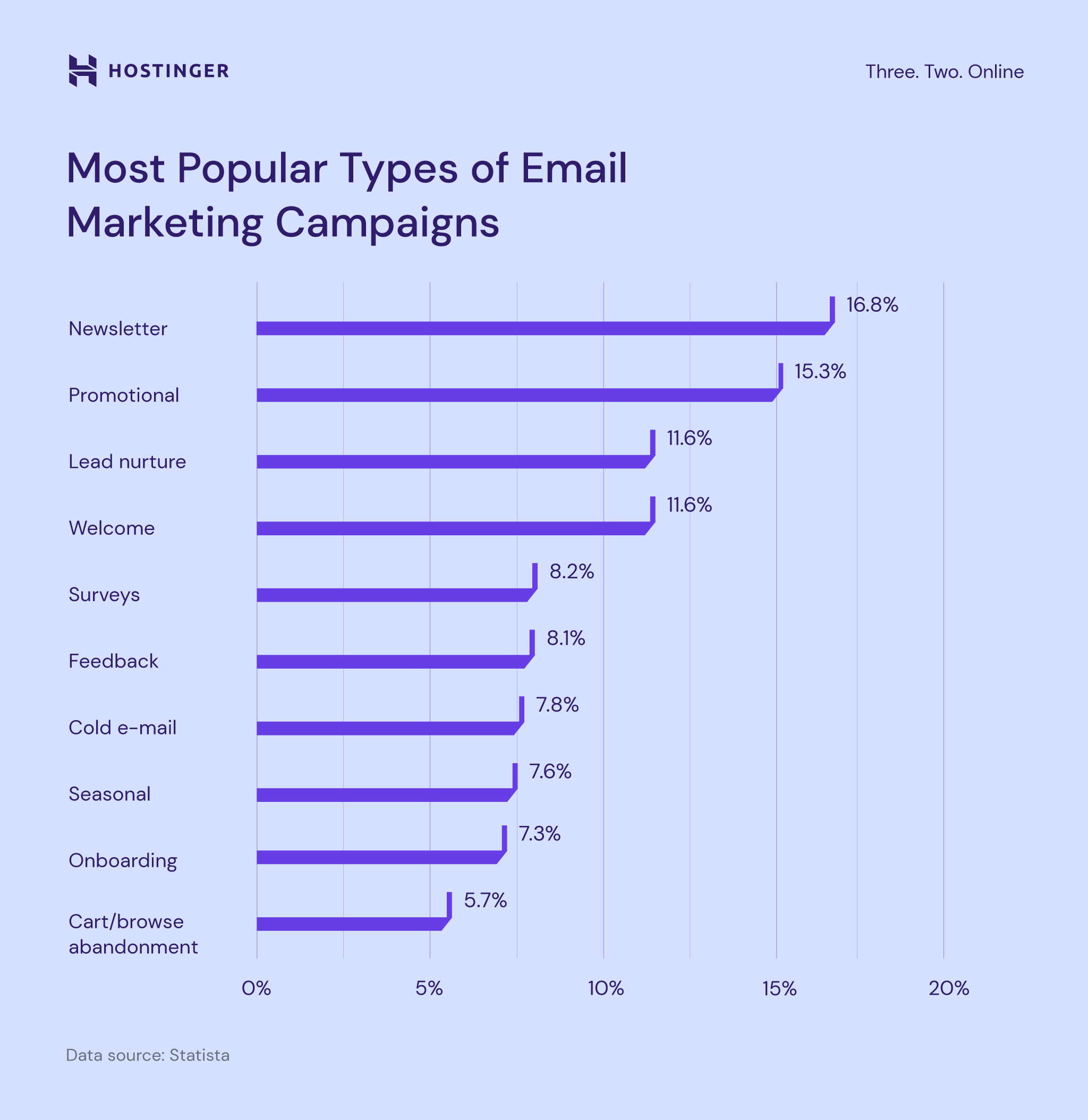
In 2023, newsletters were used by 16.8% of marketers, followed by promotional content (15.3%), lead nurture campaigns (11.6%), and welcome emails (11.6%). The least popular type of email marketing was cart abandonment message, with only 5.7% of professionals using it.
We have a dedicated tutorial on creating an email newsletter – check that out if you want to connect with your audience.
32. The Average Email Click-Through Rate Is 1.89%
That said, the exact number depends on your specific industry. For example, communication and publishing companies have the highest click-through rates, with 5.77% and 5.43%.
There are also fields with a CTR lower than the average, such as beauty (1.78%), health care (1.72%), and internet marketing (1.68%).
33. Automation Is More Common in Email Marketing Than Social Media and Content Management
58% of marketing decision-makers use automation in their email campaigns – this is higher than both social media management (49%) and content management (33%).
Thanks to automation, marketers can send emails based on a predetermined schedule, ensuring timely delivery without the need for manual intervention. The best part? It actually brings positive results, as around 33% of recipients who opened automated emails ended up making a purchase.
Social Media Marketing Statistics
With more than 5 billion active user accounts, social media is a goldmine for brands to engage with a wider audience. Let’s explore some important digital marketing statistics you can leverage to build a considerable social following.
34. Global Market Value of Influencer Marketing Is Set to Reach a Record-High $24 Billion in 2024
If the latest influencer marketing statistics tell us anything, it is the fact that brands are willing to spend more on influencer partnerships than ever before.
Working with well-known content creators on platforms like Instagram and TikTok opens the door to higher brand awareness, user engagement, and product sales.
35. TikTok Emerges as an Advertising Powerhouse
TikTok is the fastest-growing social media platform, with a 55% increase in advertising revenue. In 2022, the short-video platform generated $11.6 billion from ads, and the sum is expected to double to $23.6 billion by the end of 2024.
Although it still has a long way to match Facebook’s numbers, TikTok’s rapid growth and unique user demographics signify its emergence as a promising platform for advertisers looking to reach the younger generation.
36. Nearly 50% of Millenials Find Influencer Recommendations More Engaging Than Regular Ads
While advertising is still very effective, the trend shows that millennials trust the opinions of influencers more these days. 45% even said that they are more likely to buy products recommended by influencers.
37. Increased Exposure Is the Leading Benefit of Using Social Media for Marketing Purposes
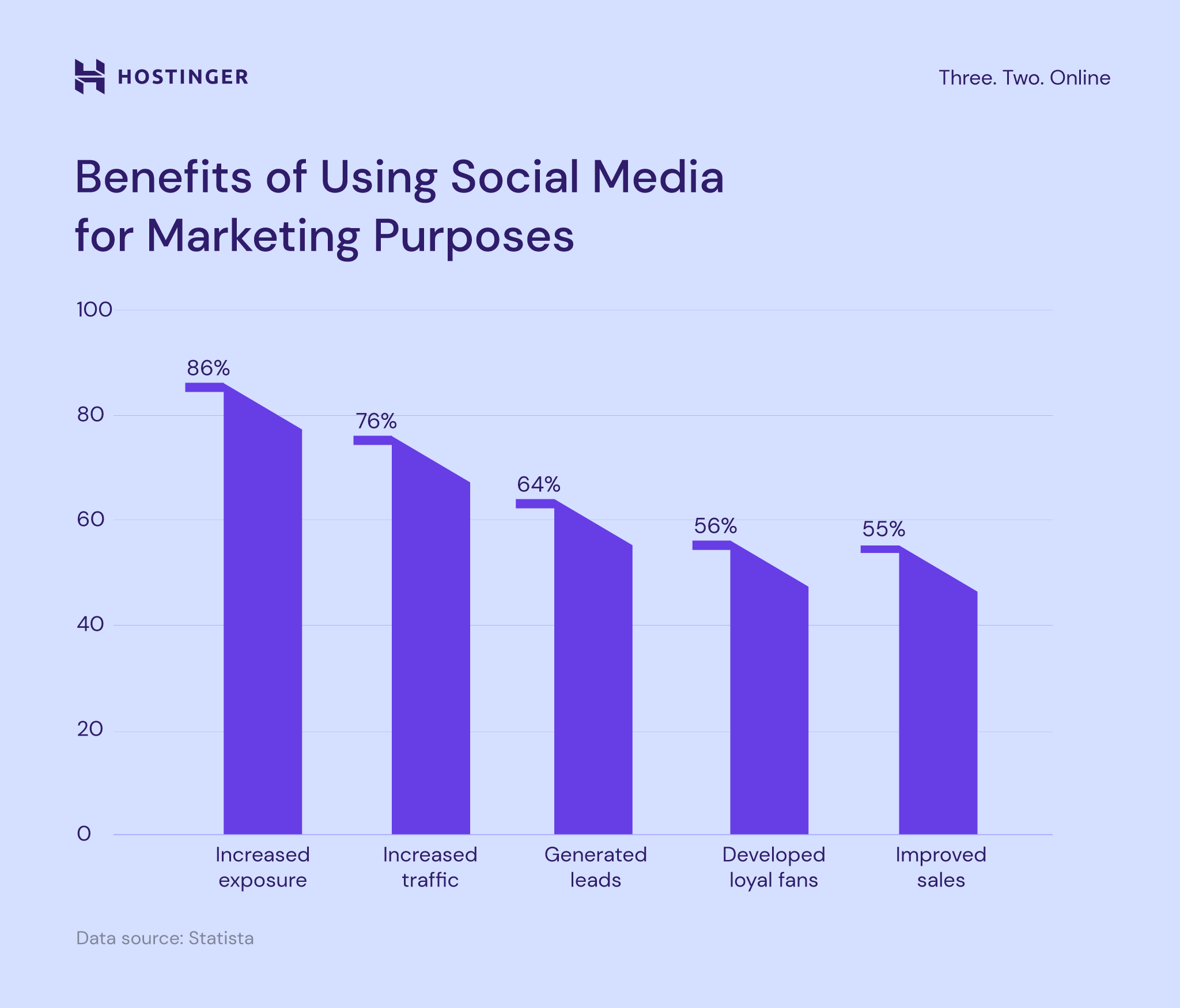
86% of marketing professionals saw social media as a key tool in improving brand exposure, while 76% believed it has helped them increase site traffic. Marketers also employ social media to generate leads (64%), build a loyal fan base (56%), and boost sales (55%).
38. Facebook Offers the Best Social Commerce Experience
Thanks to features like Shops and a large marketplace community, 23% of global consumers rate Facebook as the best social commerce platform. Instagram, which is also owned by Facebook’s parent company Meta, comes second with an 18% vote.
Other platforms that make the list include YouTube (8%), TikTok (8%), WhatsApp (7%), Pinterest (2%), Telegram (2%), and X (2%).
Marketing Technology (MarTech) Statistics
Using emerging technologies like machine learning and automation tools has become common practice in the marketing industry. Failing to catch up with this trend may leave your business trailing behind competitors.
Don’t let that happen to you. Learn how marketing technologies can help your company optimize its strategies, enhance customer experiences, and drive measurable results like never before.
39. The Market Size of Marketing Technology Reached $670 Billion in 2023
This figure grew by 31%, from $508 billion the year before. Looking at this upward trend, it’s safe to say that more and more businesses have invested in technologies to optimize their marketing efforts.
40. There Are Over 13,000 Marketing Technology Solutions
Despite recent economic challenges, the MarTech software industry is still going strong, growing by 18.5% from 2023 to 2024. Most experts believe that generative artificial intelligence (AI) is responsible for 73% of this increase.
HubSpot is the leading marketing technology software with a 37.5% market share, followed by Adobe Experience Cloud (7.73%) and Oracle Marketing Cloud (7.45%).
41. Around 76% of Businesses Have Adopted Marketing Automation
26% of CMOs were very happy with the success rate of their marketing automation strategy, while 69% reported achieving moderate success. Only 3% were unsuccessful in meeting their goals with automation.
42. Marketers Employ AI to Optimize Content Creation
Producing high-quality content is a time-consuming process, and small businesses usually don’t have the resources to do that consistently. This is where AI marketing tools can help speed up the process.
Marketing professionals use AI to create first drafts (54%), optimize content (43%), check spelling and grammar (42%), paraphrase and summarize (38%), create a tone of voice documents (27%), and perform translation tasks (25%).
43. Improved Targeting Is the Main Benefit of Marketing Automation
More than half of marketers (60%) believed improved targeting is the leading advantage of marketing automation. 41% mentioned higher efficiency and ROI, while 39% said better customer experiences.
44. Cost Is the Leading Disadvantage of Marketing Technology Solutions
When asked if there are any drawbacks to their current marketing technology stack, 53% of marketers said that it’s too expensive, and 28% felt overwhelmed by the complexities.
The lack of tool integrations (25%), customization capabilities (20%), and customer support (17%) were also the top complaints shared by respondents.
Digital Marketing Evolution
Digital marketing is always evolving, and staying updated with the latest marketing trends is key to staying ahead of the competition.
Based on the digital marketing statistics we’ve compiled in this article, it’s clear that digital platforms have replaced traditional marketing media as the primary marketing channel for businesses and professionals worldwide.
However, with so many digital marketing strategies available, which one should you focus on? It will depend on your business type and goals.
For example, a clothing brand would benefit from having an eCommerce website and engaging in influencer partnerships. On the other hand, if you’re running a local coffee shop, then implementing local SEO best practices can do wonders.
Test different marketing channels and tactics to find the perfect fit. Don’t be afraid to pivot and adjust your strategies accordingly if new marketing technologies emerge in the future.
Sources
- Statista
- Forbes
- Sprout Social
- HubSpot
- Semrush
- Exploding Topics
- WPBeginner
- GetResponse
- Search Engine Journal
- Backlinko
- Statcounter
- First Page Sage
- Vidyard
- Wyzowl
- QuickFrame
- Ascend2
- Iterable
- Gitnux
- IMARC Group
- Gartner
- Market.US
- Colorlib
Digital Marketing Statistics FAQ
Find answers to some of the most commonly asked questions about digital marketing statistics and facts below.
What Percentage of Businesses Use Digital Marketing?
Around 58% of small businesses use some form of digital marketing. The most popular digital marketing channels for small businesses are social media, website, email marketing, SEO, video, and content marketing.
How Rapidly Is the Digital Marketing Industry Expanding?
The digital marketing industry is expected to grow at a compound annual growth rate of 13.6% for the next decade, growing from $366 billion in 2023 to a whopping $1.3 trillion by 2033.
Is Digital Marketing More Effective Than Traditional Marketing?
It depends on your goals. Traditional marketing channels like television commercials are great at reaching broader audiences and building brand awareness.
On the other hand, digital marketing is more effective in targeting specific demographics. It provides more detailed analytics, so you have the flexibility to perform A/B testing, track ROI, and adjust strategies in real time.
How Successful Is a Digital Marketing Career?
According to Forbes, digital marketing is one of the fastest-growing in-demand skills for 2024 and beyond. In fact, digital marketing jobs are set to experience a 6% increase, which is higher than the average job growth rate.
If you’re interested in this career path, there are numerous digital marketing jobs to consider, including social media manager, graphic designer, content writer, SEO specialist, and web developer. Once you’ve gained enough experience, you can even grow your own digital marketing agency.

